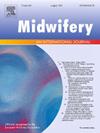The efficacy of abdominal binder in women undergoing cesarean delivery: A meta-analysis of randomized controlled trials
IF 2.6
3区 医学
Q1 NURSING
引用次数: 0
Abstract
Background
Abdominal binders are a prominent non-pharmacological intervention aimed at mitigating adverse outcomes following Cesarean delivery (CD), including pain and distress.
Aim
We conducted a meta-analysis to quantitatively evaluate the effects of abdominal binders on women undergoing CD.
Methods
A systematic search was conducted using terms such as "abdominal binder," "clinical trials," and variations of "cesarean" across multiple electronic databases, including PubMed, Google Scholar, Embase, Cochrane Central Register of Controlled Trials, ClinicalTrials.gov, Chinese National Knowledge Infrastructure (CNKI), and Wan-Fang database, up to November 2024. Study quality was assessed using the Cochrane Risk of Bias Tool 2.0. Statistical analysis was performed using Review Manager 5.4 and Comprehensive Meta-Analysis 4.0. Randomized controlled trials (RCTs) evaluating the use of abdominal binders compared to no binder usage following CD were included. The outcomes analyzed were postoperative pain, symptom distress, ambulatory function, and the occurrence of adverse effects.
Results
Thirteen RCTs were included. Abdominal binders demonstrated a strong safety profile with no significant differences in postoperative complications between groups. Significant pain reductions were observed at 6, 12, 24, and 48 h postoperatively (weighted mean differences [WMD]: -1.13, 95 % confidence interval [CI]: -2.15 to -0.10, p = 0.03; WMD: -1.48, 95 % CI: -2.90 to -0.06, p = 0.04;WMD: -0.95, 95 % CI: -1.49 to -0.41, p = 0.0005; and WMD: -0.70, 95 % CI: -1.17 to -0.22, p = 0.004, respectively). Pain interference with breastfeeding was significantly lower in the binder group (WMD: -1.30, 95 % CI: -2.24 to -0.36, p = 0.006). Symptom Distress Scale scores were significantly reduced at 24 and 48 h (WMD: -1.22, 95 % CI: -2.05 to -0.39, p = 0.004; WMD: -1.63, 95 % CI: -2.67 to -0.60, p = 0.002). Improved ambulatory function was also observed at 8, 12, and 24 h (WMD: 20.57, 95 % CI: 16.91 to 24.23, p < 0.00001; WMD: 11.97, 95 % CI: 7.67 to 16.27, p < 0.00001; WMD: 10.14, 95 % CI: 1.89 to 18.40, p = 0.02, respectively).
Conclusions
This study uniquely demonstrates the temporal effects of abdominal binder use, with significant pain reductions noted at 6, 12, 24, and 48 h post-CD. These results provide actionable guidance for the timing of abdominal binder application, emphasizing their importance as an early intervention to optimize postoperative recovery. As a secure, cost-effective, and non-pharmacological solution, abdominal binders are strongly recommended as part of routine postpartum care for women following CD
剖宫产妇女腹夹的疗效:随机对照试验的荟萃分析。
背景:目的:我们进行了一项荟萃分析,以定量评估腹部粘合剂对剖宫产妇女的影响:方法:使用 "腹部粘合剂"、"临床试验 "和 "剖宫产 "的变体等术语,在多个电子数据库(包括PubMed、Google Scholar、Embase、Cochrane Central Register of Controlled Trials、ClinicalTrials.gov、中国国家知识基础设施(CNKI)和万方数据库)中进行了系统检索,检索期截至2024年11月。研究质量采用 Cochrane 偏倚风险工具 2.0 进行评估。使用 Review Manager 5.4 和 Comprehensive Meta-Analysis 4.0 进行统计分析。纳入的随机对照试验(RCT)评估了在 CD 术后使用腹部捆扎器与不使用捆扎器的比较。分析的结果包括术后疼痛、症状困扰、活动功能和不良反应的发生:结果:共纳入 13 项 RCT。腹部粘合剂具有很高的安全性,各组间术后并发症无明显差异。术后 6、12、24 和 48 小时疼痛明显减轻(加权平均差 [WMD]:-1.13,95% 置信区间 [CI]:-2.15 至 -0.10,P = 0.03;加权平均差 [WMD]:-1.13,95% 置信区间 [CI]:-2.15 至 -0.10)。10, p = 0.03; WMD: -1.48, 95 % CI: -2.90 to -0.06, p = 0.04; WMD: -0.95, 95 % CI: -1.49 to -0.41, p = 0.0005; WMD: -0.70, 95 % CI: -1.17 to -0.22, p = 0.004)。粘合剂组对母乳喂养的疼痛干扰明显降低(WMD:-1.30,95 % CI:-2.24 至 -0.36,p = 0.006)。24 小时和 48 小时后,症状痛苦量表评分明显降低(WMD:-1.22,95 % CI:-2.05 至 -0.39,p = 0.004;WMD:-1.63,95 % CI:-2.67 至 -0.60,p = 0.002)。在 8、12 和 24 小时内,也观察到了活动功能的改善(WMD:20.57,95 % CI:16.91 至 24.23,p < 0.00001;WMD:11.97,95 % CI:7.67 至 16.27,p < 0.00001;WMD:10.14,95 % CI:1.89 至 18.40,p = 0.02,分别):这项研究独特地展示了使用腹部粘合剂的时间效应,在腹腔穿刺术后 6、12、24 和 48 小时疼痛明显减轻。这些结果为腹部粘合剂的使用时机提供了可行的指导,强调了其作为优化术后恢复的早期干预措施的重要性。作为一种安全、经济、非药物性的解决方案,强烈建议将腹部粘合剂作为 CD 术后妇女常规产后护理的一部分。
本文章由计算机程序翻译,如有差异,请以英文原文为准。
求助全文
约1分钟内获得全文
求助全文
来源期刊

Midwifery
医学-护理
CiteScore
4.50
自引率
7.40%
发文量
221
审稿时长
13.4 weeks
期刊介绍:
Midwifery publishes the latest peer reviewed international research to inform the safety, quality, outcomes and experiences of pregnancy, birth and maternity care for childbearing women, their babies and families. The journal’s publications support midwives and maternity care providers to explore and develop their knowledge, skills and attitudes informed by best available evidence.
Midwifery provides an international, interdisciplinary forum for the publication, dissemination and discussion of advances in evidence, controversies and current research, and promotes continuing education through publication of systematic and other scholarly reviews and updates. Midwifery articles cover the cultural, clinical, psycho-social, sociological, epidemiological, education, managerial, workforce, organizational and technological areas of practice in preconception, maternal and infant care.
The journal welcomes the highest quality scholarly research that employs rigorous methodology. Midwifery is a leading international journal in midwifery and maternal health with a current impact factor of 1.861 (© Thomson Reuters Journal Citation Reports 2016) and employs a double-blind peer review process.
 求助内容:
求助内容: 应助结果提醒方式:
应助结果提醒方式:


